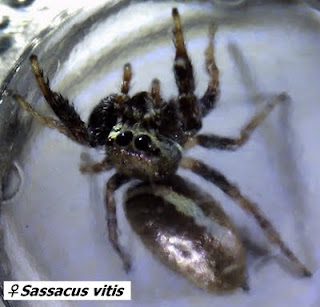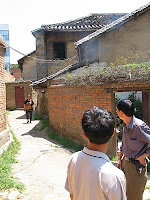Open-air Arthropodarium on a Charlotte Corday
Saturday, June 25, 2011
 School is out, so it's catch-up time here at Capers. All the thoughts and observations that I've carried around since things accelerated in March can finally find a place to land.
School is out, so it's catch-up time here at Capers. All the thoughts and observations that I've carried around since things accelerated in March can finally find a place to land.
In the few minutes I could snatch here or there over the last couple of weeks, I’ve been enjoying a hedge of passion vines and grapes that I started last summer. Over the winter, I covered (and saved) some of the passion vines with clear plastic, and learned a lesson from what I never got covered. A freeze came on suddenly just before Thanksgiving. Then the winter turned mild but wet. The rains continued longer than I can ever remember. I covered a length of about 16 feet (8 to 10 feet high), but I never quite got the plastic as far as the P. amethyst. It survived the worst cold and still had green on it until almost the end March, but then it died. I have since read that some prefer dry ground when it is cold. I replaced the dead one as soon as Lowes put the spring vines out, and next winter I will cover it.
The section I protected included the bright red P. vitafolia, the maracuya-bearing P. frederick, and what the big-box home-improvement center had labeled as P. victoria (which is lavender), but turns out to be one of the whites, either ‘Charlotte Corday,’ or ‘Constance Elliott.’ Until someone corrects me, I will go with the former, named for the ‘Angel of Assassination’ who went to the guillotine for stabbing-to-death Jacobin leader Jean-Paul Marat in his bath-tub. She hoped it would end the Reign of Terror. In actuality, it turned them each into martyrs, one for each side, but among Reign-of-Terror floral remembrances, this flower stands out as perhaps the most delicate. As a history teacher, it’s hard to imagine planting anything in my yard with more history than that.
The white one has been blooming for a couple of months, and has set dozens of fruit. The vitafolia and frederick just began blooming last week. The primary pollinators for passion flowers are bumble bees. In our area, that’s the Valley Carpenter Bee, Xylocopa veripuncta. I see them mainly in the late afternoon, most often two of the black females, and occasionally a single tan-orange male. He seems mostly to be checking things out, and I don’t see him land anywhere. They don’t seem to mind either me or the camera, and when the females are intent on a flower, they let me approach within four or five inches. The bees are just the right height to brush under the five overhanging anthers, picking up pollen on their backs, and carrying it to deposit against the three stigmas. They seem to prefer the whites, visit the frederick only after several visits to each of the available white blossoms, and show no interest at all in the vitafolia.
The bees are just the right height to brush under the five overhanging anthers, picking up pollen on their backs, and carrying it to deposit against the three stigmas. They seem to prefer the whites, visit the frederick only after several visits to each of the available white blossoms, and show no interest at all in the vitafolia.

In early June, I began seeing a California Hairstreak Satyrium.
A week later, the first Gulf Fritillary arrived.
The Argentine Ant tends to dominate my yard, but so far I have not seen them tending herds of scale insects.
So far, I have seen four species of spiders in my hedge.

Cheiracanthium mildei needed no introduction: It was already everywhere.

Of the spiders that show up as hedge residents, my two favorites are jumping spiders (family Salticidae). The male Thiodina hespera took exception to being photographed, but I will have the rest of the summer to get a clearer picture. This was the species that first attracted my attention and launched my interest in spiders, some 37 years ago, so we are old friends. Back then, using my first set of close-up lenses, I took my first spider pictures and sent them off to a scholar studying this genus. In those days, the species had no name, and I heard recently that the specialist considered naming the species after me. I don't think my little investigations would have justified that, but it helps explain why I consider this Thiodina almost a member of the family.

The second jumping spider was a female Sassacus vitis. She appeared just after a microscope I had ordered arrived in the mail. She thereby won the right to be my first subject under the new apparatus. On a leaf, her iridescent scales would catch the sun and cast a glint of golden bronze. She is loose again on my hedge, and I will try again to catch a picture of that glint.
The summer and my hedge are still young. I will be traveling some, and trying to write for a portion of each day. But my microscope is brand new, my arthropodarium is just beginning, and school doesn't start for another eight weeks. Life is sweet.
Labels: California, Entomology, Garden, History, Photography, Plants and Flowers, Spiders, Teaching, The Writing Life, Visalia







